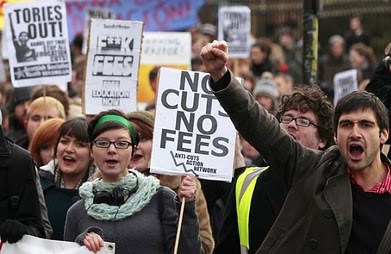Roots of Our Rights - Democrat January-February 2011 (Number 122)
The Right to Demonstrate
Bloody Sunday 1887 by Ruth Frow*

Nothing much changes it seems when one by-stander died whilst G20 demonstrations were taking place and the Commissioner of the Metropolitan Police questioning the right to demonstrate following the recent student's demonstrations.
We take it for granted that we can hold a meeting or demonstration in a public place providing we inform the Police and comply with their directions as to traffic and public safety. But that calm assumption (not always as easy as it sounds) has only been won, not given.
On 13 November, 1887 a large crowd assembled in Trafalgar Square to protest against Coercion in Ireland. The Police were there in force both on foot and on horseback. Alfred Linnell a poverty stricken law writer walked down Northumberland Street to see what was happening when the Police started charging across the crowd. He was unable to get out of the way and fell in the path of one of the mounted Policemen who rode over him. His hip was badly broken and pieces of bone broke through the skin. After some delay when the man was in obvious agony, spectators picked him up and carried him to Charing Cross Hospital.
His leg became septic and he died after five days. Then began a soap opera scenario of mismanagement and heartless behaviour on the part of the authorities with. which we can empathise. There were three deaths on that day and the bodies were confused and delivered to the wrong relatives. Linnell's body was retrieved and kept for a Post Mortem. The Police denied all evidence of reckless and unnecessary violence.
Linnell's death became the focus for popular outrage and it was decided to hold a public funeral starting from the place where he had been knocked down. Sir Charles Warren, Commissioner of Police, forbade any procession to pass through the Square. That was the last straw and on 16 December, William Morris headed a huge procession estimated to be the largest since the death of Wellington over thirty years earlier. Morris made a moving speech at the graveside and the ceremony ended with everyone singing his poem written for the occasion A Death Song the proceeds from the sale of which were given to Linnell's children. We have seen many huge demonstrations in Trafalgar Square since 1887 .No question we shall need many more before Morris's prophesy that “in the cloudy dawn the sun arisen Brings us our day of work to win the best”. It was the Socialists who organised the funeral and established our right to use public places for such demonstrations. We owe them a lot and must ensure that we maintain that right whenever needed.
- - - - - -
* Reproduced from Roots of Our Rights book II based on the original series in the Democrat. Both vol.I and II by Eddie and Ruth Frow are available for just £2.40 the pair post free from CAEF.